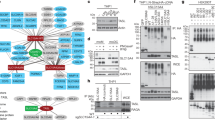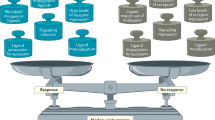Abstract
Mammalian Toll-like receptors (TLRs) recognize conserved products of microbial metabolism and activate NF-κB and other signaling pathways through the adapter protein MyD88. Although some cellular responses are completely abolished in MyD88-deficient mice, TLR4, but not TLR9, can activate NF-κB and mitogen-activated protein kinases and induce dendritic cell maturation in the absence of MyD88. These differences suggest that another adapter must exist that can mediate MyD88-independent signaling in response to TLR4 ligation. We have identified and characterized a Toll–interleukin 1 receptor (TIR) domain–containing adapter protein (TIRAP) and have shown that it controls activation of MyD88-independent signaling pathways downstream of TLR4. We have also shown that the double-stranded RNA-binding protein kinase PKR is a component of both the TIRAP- and MyD88-dependent signaling pathways.
This is a preview of subscription content, access via your institution
Access options
Subscribe to this journal
Receive 12 print issues and online access
$209.00 per year
only $17.42 per issue
Buy this article
- Purchase on Springer Link
- Instant access to full article PDF
Prices may be subject to local taxes which are calculated during checkout






Similar content being viewed by others
References
Aderem, A. & Ulevitch, R. J. Toll-like receptors in the induction of the innate immune response. Nature 406, 782–787 (2000).
Hayashi, F. et al. The innate immune response to bacterial flagellin is mediated by Toll-like receptor 5. Nature 410, 1099–1103 (2001).
Hemmi, H. et al. A Toll-like receptor recognizes bacterial DNA. Nature 408, 740–745 (2000).
Kopp, E. B. & Medzhitov, R. The Toll-receptor family and control of innate immunity. Curr. Opin. Immunol. 11, 13–18 (1999).
Kawai, T., Adachi, O., Ogawa, T., Takeda, K. & Akira, S. Unresponsiveness of MyD88-deficient mice to endotoxin. Immunity 11, 115–122 (1999).
Schnare, M., Holt, A. C., Takeda, K., Akira, S. & Medzhitov, R. Recognition of CpG DNA is mediated by signaling pathways dependent on the adaptor protein MyD88. Curr. Biol. 10, 1139–1142 (2000).
Kaisho, T., Takeuchi, O., Kawai, T., Hoshino, K. & Akira, S. Endotoxin-induced maturation of myd88-deficient dendritic cells. J. Immunol. 166, 5688–5694 (2001).
Adachi, O. et al. Targeted disruption of the MyD88 gene results in loss of IL-1- and IL- 18-mediated function. Immunity 9, 143–150 (1998).
Takeuchi, O. et al. Cutting edge: preferentially the R-stereoisomer of the mycoplasmal lipopeptide macrophage-activating lipopeptide-2 activates immune cells through a toll-like receptor 2- and MyD88-dependent signaling pathway. J. Immunol. 164, 554–557 (2000).
Goh, K. C., deVeer, M. J. & Williams, B. R. The protein kinase PKR is required for p38 MAPK activation and the innate immune response to bacterial endotoxin. EMBO J. 19, 4292–4297 (2000).
Poltorak, A. et al. Defective LPS signaling in C3H/HeJ and C57BL/10ScCr mice: mutations in Tlr4 gene. Science 282, 2085–2088 (1998).
Underhill, D. et al. The Toll-like receptor 2 is recruited to macrophage phagosomes and discriminates between pathogens. Nature 401, 811–815 (1999).
Xu, Y. et al. Structural basis for signal transduction by the Toll/interleukin-1 receptor domains. Nature 408, 111–115 (2000).
Lee, T. G., Tang, N., Thompson, S., Miller, J. & Katze, M. G. The 58,000-dalton cellular inhibitor of the interferon-induced double-stranded RNA-activated protein kinase (PKR) is a member of the tetratricopeptide repeat family of proteins. Mol. Cell. Biol. 14, 2331–2342 (1994).
Patel, R. C. & Sen, G. C. PACT, a protein activator of the interferon-induced protein kinase, PKR. EMBO J. 17, 4379–4390 (1998).
Derossi, D., Chassaing, G. & Prochiantz, A. Trojan peptides: the penetratin system for intracellular delivery. Trends Cell. Biol. 8, 84–87 (1998).
Ozinsky, A. et al. The repertoire for pattern recognition of pathogens by the innate immune system is defined by cooperation between toll-like receptors. Proc. Natl Acad. Sci. USA 97, 13766–13771 (2000).
Arbibe, L. et al. Toll-like receptor 2-mediated NF-κB activation requires a Rac1-dependent pathway. Nature Immunol. 1, 533–540 (2000).
Medzhitov, R., Preston-Hurlburt, P. & Janeway, C. A. Jr A human homologue of the Drosophilia Toll protein signals activation of adaptive immunity. Nature 388, 394–397 (1997).
Acknowledgements
We thank S. Akira for MyD88-deficient mice; M. Katze and L. Jensen for p58 and IL-1R plasmids; and L. Kopp for helpful discussions and critical reading of the manuscript. Supported by NIH grant AI44220-01, the Searle Foundation (R. M.) and the Howard Hughes Medical Institute (R. M. and T. H.).
Author information
Authors and Affiliations
Corresponding author
Rights and permissions
About this article
Cite this article
Horng, T., Barton, G. & Medzhitov, R. TIRAP: an adapter molecule in the Toll signaling pathway. Nat Immunol 2, 835–841 (2001). https://doi.org/10.1038/ni0901-835
Received:
Accepted:
Issue Date:
DOI: https://doi.org/10.1038/ni0901-835
This article is cited by
-
Scavenger receptor B1 facilitates the endocytosis of Escherichia coli via TLR4 signaling in mammary gland infection
Cell Communication and Signaling (2023)
-
POU5F1 promotes the proliferation, migration, and invasion of gastric cancer cells by reducing the ubiquitination level of TRAF6
Cell Death & Disease (2023)
-
A NF-κB-Based High-Throughput Screening for Immune Adjuvants and Inhibitors
Inflammation (2023)
-
The importance of N6-methyladenosine modification in tumor immunity and immunotherapy
Experimental Hematology & Oncology (2022)
-
Lipopolysaccharide inhibits osteogenic differentiation of periodontal ligament stem cells partially through toll-like receptor 4-mediated ephrinB2 downregulation
Clinical Oral Investigations (2020)



